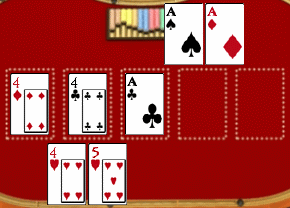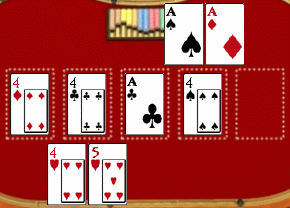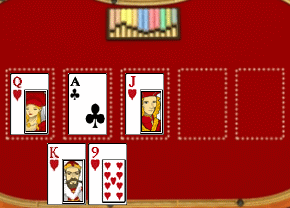What are ‘Outs’ in Texas Holdem?
02
Feb 2008
In Holdem poker, ‘Outs’ refers to the number of cards remaining in the deck that could improve your hand in various ways. Whenever we calculate the number of outs we do so by looking only at the cards that are visible. After the flop has been laid down there are usually five cards visible – your two hole cards and the three flop cards on the table.
Let’s take a look at an example where you only have one ‘out’, but for the purpose of the example we will say that both you and your opponent have gone ‘all-in’ and so both of you have shown your cards. Now there are seven cards visible. You have 4h5h and your opponent has a pair of Aces. This is what the table looks like;
All-in After the Flop

Your opponent already has flopped a full house, so you must get either a higher full house, four of a kind or a straight flush to beat him. How many cards are there left in the deck that could give you the winning hand in this situation?
Since there is no card or pair of cards that could give you a higher full house, and a straight flush is no longer possible, the only way you can beat your opponents full house is with quads, or four of a kind. And the only possible quads you could get would be four 4’s. Since three of the 4’s are already visible, only one card – the 4 of Spades – could give you the opportunity to win the game. In this situation then, we say that you only have only one ‘out’, that ‘out’ being the 4 of Spades.
Let’s continue the example and say that you did get your 4 of Spades on the turn. Now the table looks like this;

You now have quad 4’s to your opponent’s full house, and the only way that he could beat you would be to get quad Aces. Since three Aces are already showing, your opponent would now have only one ‘out’. Only the Ace of Hearts could give him quad Aces to beat your quad 4’s.
That’s an extreme example however. In actual play you would very rarely see a situation where you had only one ‘out’. Normally with any given hole cards there are a few different types of hands you could try to assemble, so you have several ‘outs’. Here is an example that you would be more likely to encounter in a real game of Holdem;

Here you can see that you have quite a few ‘outs’ to improve your hand. First of all you have four hearts so one more heart would give you a flush. Also, a Ten would give you an Ace high Straight. There are 13 hearts in the deck, but 4 of them are already showing, so only 9 hearts remain in the deck. All 4 Tens are still in the deck, however one of them is the Ten of hearts and is therefore is already counted among the 9 hearts. So actually only the other 3 Tens can be counted as ‘outs’. The 9 remaining hearts plus the 3 Tens equals 12 cards remaining that could help you to get either a straight or a flush. We say then that you have 12 ‘outs’.
You probably can see that there are actually even more ‘outs’ available that we didn’t mention. For example, a King or a Nine would give you a pair, and thus those are also valid ‘outs’. The reason we didn’t mention them however is that a pair of Kings or Nines is not a very strong hand in this situation since an opponent with even one Ace in his hole cards could beat a pair of Kings, and any opponent would only need a single Ace, a Queen or a Jack in his hole cards to beat a pair of Nines.
Knowing how many ‘outs’ you have is extremely important because the odds of getting a winning hand change depending on how many ‘outs’ you have. It’s important that you read other articles in this series to see what the odds are of getting different numbers and types of ‘outs’, and that you take those odds into account when betting on your Texas Holdem cards.
Previous Article: Free Poker News
Next Article: Best Starting Hands in Texas Holdem, Part One



